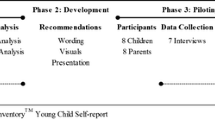Abstract
Objectives: Qualitative methodology has been under-utilized in child health research due to lack of a specific set of instruments. The objective of this study was to develop a child-centred qualitative research methodology to facilitate direct exploration of health-related quality of life (HRQL) issues and to identify the quality of life elements in pre-adolescent children with a chronic medical condition. Study Design: Purposeful stratified sampling of children, ages 6–12, who function in a regular school class, with active epilepsy who were assembled in small focus groups. The groups met in four phases and were led by moderators who probed preset open questions and activities. Results: The study demonstrated that our modified focus groups process was a powerful exploratory experience eliciting meaningful and important issues in quality of life beyond what parents and health professionals expected, and helped identify HRQL elements in childhood epilepsy. Conclusion: Modified focus groups are appropriate and suitable to explore quality of life issues in pre-adolescent children with a chronic medical condition. The process is feasible and trustworthy.
Similar content being viewed by others
References
Bradlyn AS, Ritchey AK, Harris CV. Quality of life research in pediatric oncology: Research methods and barriers. Cancer 1996; 78: 1833–1339.
Schipper H, Clinch JJ, Olweny LM. Quality of life studies: Definitions and conceptual issues. In: Spilker B (ed.) Quality of Life and Pharmacoeconomics in Clinical Trials. Philadelphia, PA: Lippincott-Raven, 1996: 11–23.
Crabtree BJ, Miller WL (eds). Doing qualitative research. Research methods for primary care, Vol. 3, Newbury Park, CA: Sage Publications Inc., 1991.
Goering PN, Streiner DL. Reconcilable differences: The marriage of qualitative and quantitative methods. Can J Psychiatry 1996; 41: 491–497.
Folch-Lyon E, Trost JF. Conducting focus group sessions. Stud Fam Plann 1981; 12: 443–449.
Editorial. Population health looking upstream. Lancet 1994; 343: 429–430.
Hoppe MJ, Wells EA, Morrison DM, Gillmore MR, Wilsdon A. Using focus groups to discuss sensitive topics with children. Eval Rev 1995; 19: 102–114.
Fiese BH, Bickham NL. Qualitative inquiry: An overview for pediatric psychology. J Pediatr Psychol 1998; 23: 79–86.
Jenney ME, Campbell S. Measuring quality of life. Arch Dis Child 1997; 77: 347–350.
Landgraf JM, Abetz LN. Measuring Health outcomes in pediatric populations: Issue in psychometrics and application. In: Spilker B (ed.) Quality of Life and Pharmacoeconomics in Clinical Trials. Philadelphia, PA: Lippincott-Raven, 1996: 793–802.
McLauglin JF, Bjornson K. Quality of Life and developmental disabilities, editorial. Dev Med Child Neurol 1998; 40: 435.
Ronen GM, Rosenbaum P, Law M, Streiner DL. Health-related quality of life in childhood epilepsy: The results of children's participating in identifying the components. Dev Med Child Neurol 1999; 41: 554–559.
Patton MW. Qualitative Evaluation and Research Methods. 2nd ed. Newbury Park, CA: WL Sage Publication, 1990: 169–186.
Krueger RA. Focus groups. A Practical Guide for Applied Research. Newbury Park, CA: Sage Publications, 1994.
Stewart DW, Shamdasani PN. Focus Groups: Theory and Practice. Newbury Park, CA: Sage Publications, 1990.
Eiser C. Children's quality of life measures. Arch Dis Child 1997; 77: 350–354.
Lincoln Y, Guba E. Naturalistic inquiry. Chap. 11, Establishing Trustworthiness. Newbury Park, CA: Sage Publications, 1985: 284–331.
Hoppe MJ, Wells EA, Wilsdon A, Gillmore MR, Morrison DM. Children's knowledge and beliefs about AIDS: Qualitative data from focus group interviews. Health Educ Q 1994; 21: 117–126.
Worden JK, Flynn BS, Geller BM, et al. Development of a smoking prevention mass media program using diagnostic and formative research. Prev Med 1988; 17: 531–558.
Hockenberry-Eaton M, Hinds PS, Alcoser P, et al. Fatigue in children and adolescents with cancer. J Pediatr Oncol Nurs 1998; 15: 172–182.
French DJ, Carroll A, Christie MJ. Health-related quality of life in Australian children with asthma: Lessons for the cross-cultural use of quality of life instruments. Qual Life Res 1998; 7: 409–419.
Rae WA. Analyzing drawings of children who are physically ill and hospitalized, using the ipsative method. Child Health Care 1991; 20: 198–207.
Miles MB, Huberman AM. Qualitative Data Analysis. 2nd ed. Thousand Oaks, CA: Sage Publications, 1994.
Denzin NK. Sociological Methods: A Source Book, 2nd ed. New York: McGraw-Hill, 1978.
Rights and permissions
About this article
Cite this article
Ronen, G.M., Rosenbaum, P., Law, M. et al. Health-related quality of life in childhood disorders: A modified focus group technique to involve children. Qual Life Res 10, 71–79 (2001). https://doi.org/10.1023/A:1016659917227
Issue Date:
DOI: https://doi.org/10.1023/A:1016659917227




